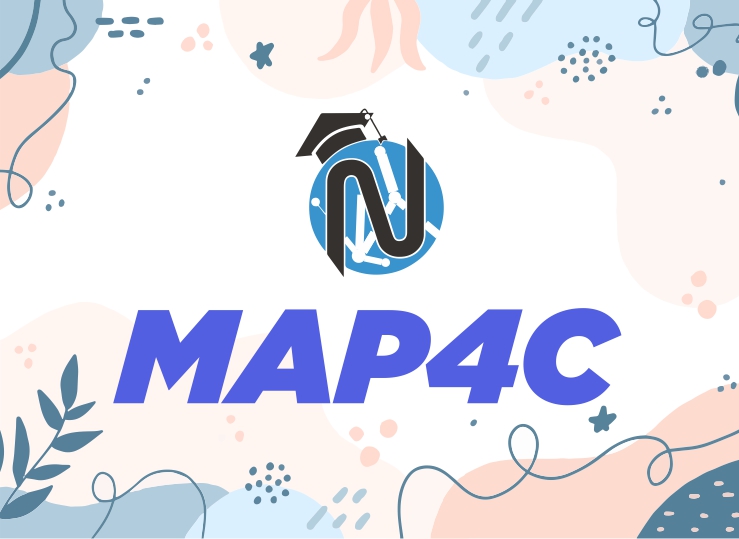
Mathematics, Foundations for College Mathematics (MAP4C)
Course Description
This course enables students to broaden their understanding of real-world applications of mathematics. Students will analyse data using statistical methods; solve problems involving applications of geometry and trigonometry; solve financial problems connected with annuities, budgets, and renting or owning accommodation; simplify expressions; and solve equations. Students will reason mathematically and communicate their thinking as they solve multi-step problems. This course prepares students for college programs in areas such as business, health sciences, and human services, and for certain skilled trades.
For Ministry Guideline Click Here
| Units | Descriptions | Length (Approximately) |
|---|---|---|
| 1. | Mathematical Models Students will evaluate powers with rational exponents, simplify algebraic expressions involving exponents, and solve problems involving exponential equations graphically and using common bases; describe trends based on the interpretation of graphs, compare graphs using initial conditions and rates of change, and solve problems by modelling relationships graphically and algebraically; make connections between formulas and linear, quadratic, and exponential relations, solve problems using formulas arising from real-world applications, and describe applications of mathematical modelling in various occupations. |
30 hours |
| 2. | Personal finance Students will demonstrate an understanding of annuities, including mortgages, and solve related problems using technology; gather, interpret, and compare information about owning or renting accommodation, and solve problems involving the associated costs; design, justify, and adjust budgets for individuals and families described in case studies, and describe applications of the mathematics of personal finance. |
20 hours |
| 3. | Geometry and Trigonometry Students will solve problems involving measurement and geometry and arising from real-world applications; explain the significance of optimal dimensions in real-world applications, and determine optimal dimensions of two-dimensional shapes and three-dimensional figures; solve problems using primary trigonometric ratios of acute and obtuse angles, the sine law, and the cosine law, including problems arising from real-world applications, and describe applications of trigonometry in various occupations. |
25 hours |
| 4. | Data Management Student will collect, analyze, and summarize two-variable data using a variety of tools and strategies, and interpret and draw conclusions from the data; demonstrate an understanding of the applications of data management used by the media and the advertising industry and in various occupations |
25 hours |
| The final assessment task is to provide students to do Exam Review (4 Hrs) +Formative Exam (2 Hrs) +Culminating Task (2 Hrs) + Final Exam (2 Hrs) | 10 hours | |
| Total | 110 hours | |
Overall Curriculum Expectations
By the end of this course, students will:
- evaluate powers with rational exponents, simplify algebraic expressions involving exponents, and solve problems involving exponential equations graphically and using common bases.
- describe trends based on the interpretation of graphs, compare graphs using initial conditions and rates of change, and solve problems by modeling relationships graphically and algebraically.
- make connections between formulas and linear, quadratic, and exponential relations, solve problems using formulas arising from real-world applications, and describe applications of mathematical modeling in various occupations.
By the end of this course, students will:
- demonstrate an understanding of annuities, including mortgages, and solve related problems using technology.
- gather, interpret, and compare information about owning or renting accommodation, and solve problems involving the associated costs.
- design, justify, and adjust budgets for individuals and families described in case studies, and describe applications of the mathematics of personal finance.
By the end of this course, students will:
- solve problems involving measurement and geometry and arising from real-world applications
- explain the significance of optimal dimensions in real-world applications and determine optimal dimensions of two-dimensional shapes and three-dimensional figures.
- solve problems using primary trigonometric ratios of acute and obtuse angles, the sine law, and the cosine law, including problems arising from real-world applications, and describe applications of trigonometry in various occupations.
Assessment & Evaluation of student performance
Formative assessments are learning practices that provide important feedback to student progress. Examples include homework and quizzes.
Summative assessments form a foundation for final mark allotment at the end of the unit, term and final evaluation.
An achievement chart will be given to students at regular intervals and the purpose of the charts is to provide feedback to students in relation to content and performance strands.
| Knowledge and understanding | Communication | Thinking Inquiry and Problem solving | Application |
|---|---|---|---|
| 25% | 25% | 25% | 25% |
Unit Tests, Written assignments, presentations, Classroom Observations and Classroom conversations.










